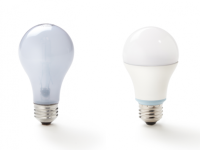-
Team TechTree
21st Apr 2017
Most people have spent their adult life buying incandescent bulbs based on their rating by Watts. It was established in the case of incandescent bulbs, the higher the wattage, the brighter would be the bulb.
However, the introduction of LED Lights, are not only replacing conventional lighting system but also the existing luminosity metrics in the market. In case of LED lights, it is the lumens which is taking precedence over the old Wattage system, today. It should be noted that Watts measure the amount of electricity required to light a luminaire, whereas lumens measure the amount of light a source produces.
With the growing twin markets; commercial LED lighting and home LED lighting, the international system of units, that is, SI Unit ‘Lumens’ is being adopted, and the ‘Wattage’ system is gradually getting obsolete.
Watts Vs Lumens
Watts is merely a unit to measure how much electricity a light source will consume. More the wattage in a light bulb, the more power it will require to get illuminated.
In the era of incandescent bulbs, wattage was the measure of power. It was considered that a 100 Watt bulb would have greater luminosity than a 60 Watt one. The reason being, the traditional filament material used in the bulbs wasted 98% of the energy, and only 2% was used in generating light. So, the only way to increase the light output was to increase the wattage. This mindset prevailed in the market for long. However, to state the reality, wattage has got nothing to do with the brightness of the bulb.
Lumen, on the other hand, measures the amount of light a source produces and is the only valid parameter to judge a light’s brightness. The higher the lumens in a light bulb, the brighter the light. For modern lighting sources like LEDs, lumen is an apt measure. As opposed to incandescent bulbs, discussed earlier, LEDs spend more than 90% of the energy on light instead of heat. As a result, a 100-watt incandescent bulb can produce approximately 1,600 lumens.
Lumens per Watt Rating
Just like kilometers-per-liters is used to measure fuel efficiency of a car, the lumens-per-watt rating measures how much light a light source produces with each wattage of power used. It is a way to measure the energy efficiency of a light source.
To explain the case further, let us go back in time. Do you remember buying a 60-watt incandescent bulb back in the day? Well today, in terms of LED, a 60-watt LED light may just blind you. A 60-watt incandescent bulb and a 60-watt LED light are not comparable. LEDs being the newer technology have high lumen output per watt and are in every way superior to the conventional lights.
For example, 60-watt incandescent bulb produces roughly around ~400-680 lumens. While on the other hand, a 60-watt LED light produces roughly around ~8000 lumens.
Making the Right Choice
Choosing adequate LED lights for your needs is essential. Since, LEDs come with several features and are manufactured for various purposes, making the right choice is essential. Be it the sphere of Commercial LED Lighting or Home LED lighting; the buyer must be clear about his needs, the area to be illuminated, the objective of illumination and then choose LEDs accordingly.
To help the customers make the right choice leading LED manufacturers enclose clear specifications with each product, like, Lumens, Wattage, Voltage and System Watts. A case in point, is Wipro lighting. The leaders in the luminaire industry are not just taking the initiative in educating the consumers about the new illumination metrics but also offer an elaborate catalog of most products that have specifications in conventional as well as contemporary metrics, to help the buyer make an informed choice. Wipro Lighting also offers a payback calculator to check the refurbishment costs of LEDs.
Conversion Chart
In countries like India, given the ignorance of the consumers, Wattage is still the prevalent metric in the market. However gradually this is changing. With the growing awareness of the LED benefits in the buyers, the modern specification metrics like Lumen, are also getting popular. So, make your decisions based on the lumen output your luminaire offers, and not merely the wattage it consumes.
Watt Vs Lumen: How To Choose Your LEDs | TechTree.com
Watt Vs Lumen: How To Choose Your LEDs
In case of LED lights, it is the lumens which is taking precedence over the old Wattage system, today.
News Corner
- DRIFE Begins Operations in Namma Bengaluru
- Sevenaire launches ‘NEPTUNE’ – 24W Portable Speaker with RGB LED Lights
- Inbase launches ‘Urban Q1 Pro’ TWS Earbuds with Smart Touch control in India
- Airtel announces Rs 6000 cashback on purchase of smartphones from leading brands
- 78% of Indians are saving to spend during the festive season and 72% will splurge on gadgets & electronics
- 5 Tips For Buying A TV This Festive Season
- Facebook launches its largest creator education program in India
- 5 educational tech toys for young and aspiring engineers
- Mid-range smartphones emerge as customer favourites this festive season, reveals Amazon survey
- COLORFUL Launches Onebot M24A1 AIO PC for Professionals







TECHTREE